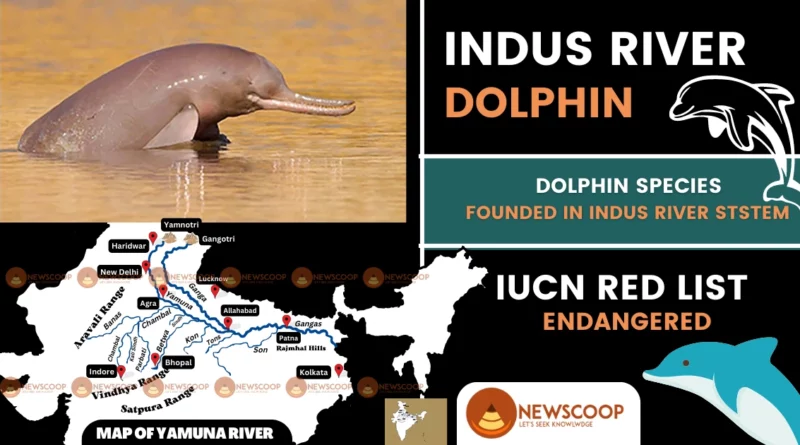Indus River Dolphin: IUCN Status & Threats
The Indus River Dolphin (Platanista Gangetica Minor) is a highly endangered aquatic mammal found exclusively in the Indus River system of Pakistan and India. With its unique characteristics and ecological significance, the Indus River Dolphin has become a subject of concern for environmentalists, policymakers, and aspirants preparing for the UPSC exam.
This article aims to provide information about the significance of the Indus River Dolphin, its endangered status, the causes of its population decline, and the necessary steps for its conservation and survival.
What is the Indus River Dolphin?
The Indus River Dolphin (Platanista gangetica minor) is an aquatic mammal species that is endemic to the Indus River system in Pakistan and India. It is a subspecies of the Ganges River Dolphin and is known for its unique features and habitat. Further, it is an important species in the ecosystem, serving as an indicator of the river’s health. Unfortunately, the Indus River Dolphin is highly endangered, facing various threats that require immediate conservation efforts for its survival.
Physical Characteristics of the Indus River Dolphin
The Indus River Dolphin (Platanista gangetica minor) possesses several distinct physical characteristics:
- They typically measure between 1.5 to 2.5 meters in length, making them relatively smaller compared to other dolphin species.
- Indus River dolphins have a streamlined body, which aids in their movement through the water.
- They possess a long, narrow snout, which is adapted for foraging in the riverbed and catching prey.
- Their eyes are small, reflecting their adaptation to the river’s low light conditions.
- Their skin is generally gray or brownish in color, enabling them to blend with the murky waters of the Indus River.
- Teeth: They have sharp, conical teeth adapted for grasping and capturing their prey, which primarily consists of small fish.
- Dorsal Fin: They have a prominent dorsal fin that is relatively larger compared to other dolphin species.
Conservation Status
The conservation status of the Indus River Dolphin (Platanista gangetica minor) is as follows:
- IUCN Red List: Endangered
- CITES: Appendix I
- Wildlife (Protection) Act, 1972: Schedule I
Where is the Indus River Dolphin found?
The Indus River Dolphin is primarily found in the Indus River system, which flows through Pakistan and India. Its distribution is limited to specific areas along the main stem of the Indus River and its tributaries. In Pakistan, it is mainly found in the provinces of Punjab and Sindh. In India, the Indus River Dolphin is found in the Jammu and Kashmir states, where the river enters Indian territory. These dolphins inhabit freshwater ecosystems within the Indus River, including deep river reaches, pools, and eddies with moderate current flow.
Habitat & Behaviour
- It is a skilled swimmer, using its streamlined body and strong tail for navigation.
- The dolphin primarily feeds on fish, using echolocation to locate its prey.
- It can be seen alone or in small groups, occasionally forming larger groups.
- The dolphin communicates through clicks, whistles, and other vocalizations.
- Being a mammal, it comes to the water’s surface to breathe through its blowhole.
- It rests near the river bottom or in shallow areas during periods of low activity.
- The dolphin engages in playful behaviors such as leaping and chasing.
- Protecting its habitat and minimizing disturbances are essential for its survival and well-being.
Importance of Indus River Dolphin
The Indus River Dolphin holds immense importance in various aspects. As an indicator species, its presence or absence reflects the health of the river ecosystem, making it a crucial barometer of environmental conditions. By regulating fish populations, the dolphin plays a vital role in maintaining the ecological balance of its habitat.
Additionally, it holds cultural and religious significance for local communities, being considered sacred and woven into their traditions. Moreover, the dolphin’s presence attracts tourists, contributing to ecotourism and generating economic opportunities for the communities living around the river.
By protecting the Indus River Dolphin, we also safeguard biodiversity, as it serves as a flagship species for the conservation of freshwater habitats. The conservation efforts focused on this species also raise awareness about the importance of preserving freshwater ecosystems and promote research and educational initiatives on aquatic conservation.
What are the Threats?
- Habitat Degradation: Dam construction, water abstraction, and changes in river flow disrupt the dolphins’ habitat and affect their breeding and feeding patterns.
- Water Pollution: Industrial effluents, agricultural runoff, and domestic waste introduce pollutants into the river, leading to water contamination and reducing prey availability.
- Overfishing: Unsustainable fishing practices and indiscriminate net use negatively impact fish populations, depleting the food source for the dolphins.
- Accidental Mortality: Entanglement in fishing gear and collisions with boats and barges result in accidental deaths of dolphins.
Efforts to Conserve Indus River Dolphin
Efforts to conserve the Indus River Dolphin include establishing protected areas, restoring habitats, engaging local communities, implementing fishing regulations, conducting research and monitoring, advocating for policy changes, and collaborating internationally. These efforts aim to protect the species, restore its habitat, and ensure its long-term survival.
Conclusion
The Indus River Dolphin is a remarkable aquatic species that require urgent conservation attention. Protecting its habitat, mitigating pollution, and promoting sustainable practices are key to ensuring the survival of this iconic mammal. Aspirants preparing for the UPSC exam should be well-versed in the significance of the Indus River Dolphin and the measures needed to conserve this endangered species for the benefit of both ecosystems and local communities.
Thank You!

